LANDSCAPE (SEASONAL MAINTENANCE)
Fall is a good time in Southern California to begin new plantings. The weather is beginning to cool down, yet temperatures are still warm enough to encourage germination. Ensure that your landscape is still fire-safe. Clear your roof of fallen debris to prevent ignition from flying embers in the event of a wildfire. Maintaining your property is a year-round task. With the start of our rainy season in mid-October, begins our Mediterranean climate’s “green season”, which is the best time to plant new young plants. Sow wildflower seeds.
Caring for Plants During Fall
 |
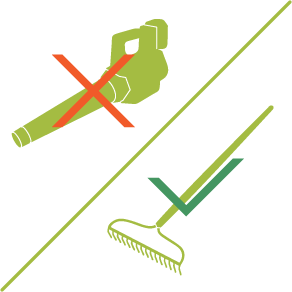 |
Prevent fallen, dried leaves from building up to dangerous levels. Use a rake, not a leaf blower (see comment below). |
||
 |
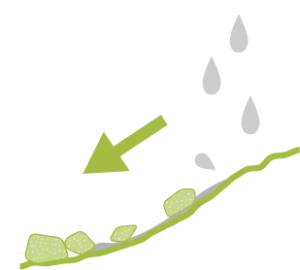 |
Prepare for rain and erosion. |
||
 |
 |
Reduce watering using smart controllers for an irrigation based on weather forecasts and the strength of the rainy season (usually November to March/April in Southern California). |
||
 |
 |
Monitor water needs of newly installed plants. The establishment phase is critical and will ensure long-term health of your landscape. |
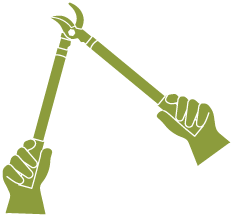 Pruning for Healthy Plants
Pruning for Healthy Plants
- Evergreen herbaceous perennials and shrubs (such as coast aster, lilac verbena, coffeeberry, toyon, coyote brush, ceanothus and manzanitas) can be pruned in the fall for rejuvenation.
- Shaping is better done by pruning plants right after they flower, unless fruits are desired for their wildlife or ornamental value.
- Semi-evergreen species (such as Matilija poppy, shrubby monkeyflowers, goldenrods, irises, and sages) can be pruned as they slow down and enter a resting period, usually in late summer to early winter. Depending on the weather and your watering practices, growth may not completely stop even during that time.
 Irrigation
Irrigation
Winter is an important time to water new plants during dry spells between rain events to get them properly established. Existing, older vegetation should also be deeply irrigated during prolonged dry spells, as this is the time of year that they depend upon moisture to stimulate growth and insure overall vigor. For more information about irrigation systems, check our Irrigation section here.
 About Leaf Blowers
About Leaf Blowers
Do not use leaf blowers, these are harmful to the environment both for noise and air pollution as well as for the balance of the wildlife ecosystem. Leaf blowers blow away mulch, topsoil decreasing your plants ability to regulate temperature and retain moisture. Leaf blowers are also a fire hazard due to the engine heat and the sparks they can generate. Use a rake instead.
Winter in Southern California is defined by the arrival of storms bringing rain at lower elevations, and often snow over 5,000 feet. Winter is a good time to care for your soil – in burned areas, erosion can be a problem. In fuel management zones, the retention of deep-rooted vegetation during spring fire hazard reduction projects should stabilize slopes.
Caring for Plants During Winter
 |
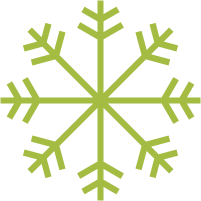 |
Many plants such as citrus, avocado and even some natives are susceptible to frost in the winter. Plants killed by frost can become a fire hazard in the Wildland Urban Interface. Help your plants survive the cold by preparing for frost in early winter (December). Move tender container plants to a protected area. For plants in the ground that are susceptible to frost, wrap trunks and branches with insulating material. |
||
 |
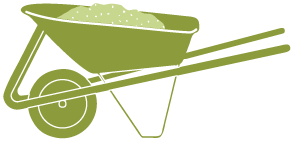 |
|
 Pruning for Healthy Plants
Pruning for Healthy Plants
- Because so many of our California woody plants are dormant in summer and do their growing when the rain kicks in, the deep of winter is usually the wrong time for pruning. Exceptions to that rule include pines. For these species, plan on making any needed structural cuts in December or January. Annual, finer pruning work on pines can be scheduled for October or November.
- Winter-deciduous species (e.g. western redbud, creek dogwood, maples, and deciduous oaks) should be pruned during their dormant period, after leaf drop. It is much easier to spot structural problems such as crossing limbs at this time of the year, and to observe where removal of a specific branch will result in a more desirable shape.
- When it comes to structural pruning for winter-deciduous dormant trees (such as western redbud, creek dogwood, maples and deciduous oaks – not live oaks that are evergreen), review the basic rules of pruning: develop and refer to a multi-year plan, and don’t take too much off at once. Solve problems first, like crossing branches or those moving into the center of the tree. Prevent future problems by removing problem branches while they are still twigs. California pines are in deepest dormancy during the coldest time of year. Pruning in December and January will minimize sap run, and, in turn, minimize the hazard of attracting beetles to the tree.
Early spring is a good time to give your irrigation system a check-up. Water plants deeply and only as needed. This encourages deep roots and drought tolerance, and discourages weeds, overgrowth, and snails. Before you begin your spring garden tasks, be aware that most birds nest from February to August. Make sure that fuel management activities do not disturb nests. Look first before cutting.
Caring for Plants During Spring
 |
 |
|
 Pruning for Healthy Plants
Pruning for Healthy Plants
- Prune deciduous trees (before they leaf out), remove waterspouts and suckers. Look for nesting birds before you prune. Protected species require a permit before pruning. Whenever there is any doubt about clearing or thinning native brush, the US Fish and Wildlife Service and California Department of Fish and Wildlife should be consulted. Check our section on Protected Species for more information.
- Oak trees in particular are a protected species in California and require permitting. Check our section on Oak Woodlands for more information.
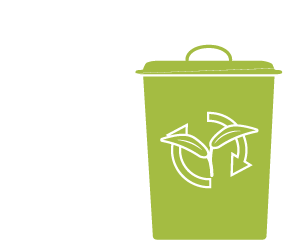
Compost for Your Garden
If you haven’t already, start composting green waste as part of your spring cleaning. Also, leaving grass clippings on your lawn as mulch provides nutrients to your soil, helps retain soil moisture, and keeps green waste out of landfills . For more information, read these publications: Compost in a Hurry and Mowing Your Lawn and “Grasscycling.”
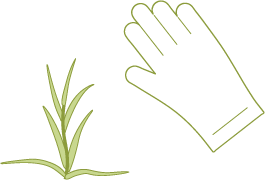 Weeds
Weeds
Spring is a critical time to pay attention to weeds that have sprouted in response to the winter rains. Check for the presence of any invasive species and remove them. Learn more about invasives in our dedicated section.
Peak summer is not the time for overzealous pruning or fertilizing, both of which can force the plant to put out new growth when it’s least likely to survive. Late summer is a good time to begin planning for the fall planting season. Local botanical gardens or community colleges host design classes that will help you make the most of your garden.
Caring for Plants During Summer
 |
 |
Water appropriately to maintain healthy leaf moisture without encouraging excess growth. Excess irrigation during the summer months can be very detrimental to native species that are used to dry summers. |
||
 |
 |
Stay ahead of weeds by maintaining a regular schedule of hand pulling or weed whipping, before the seed heads mature, to reduce fire hazard and invasive seed banks. |
||
 |
 |
Utilize mulch to suppress weeds. Review combustion characteristics of mulch treatment before making a choice of mulch type. Use composted wood chips, which produce very little flame and have the slowest rate of fire spread of 8 types of mulch treatment tested in a 2008 study. For more information: The Combustibility of Landscape Mulch. |
||
 |
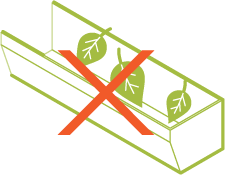 |
Dry leaves and other debris that have collected in your rain gutters can be dangerous and ignite a fire very easily. Cleaning your rain gutters regularly can prevent this from being a threat. |
 Pruning for Healthy Plants
Pruning for Healthy Plants
- Most plants will benefit from occasional corrective pruning, and all will benefit from the removal of dead wood. Time the pruning of individual plants over several years to allow them to recover. Try pruning about 1/3 of your plants in a given year, so that all are pruned at the end of three years.
- Regularly remove dead material and branches from your trees and shrubs. For deciduous trees and shrubs, prune before they lose their leaves, when it is easier to see the dead branches.
- Hand-prune inside branches to reduce flush of growth. Hedging and shearing alone results in weak, fast growth and more fuel.
- Prune Coast Live Oak trees in July-August, during dormancy period. It is best to prune when the dry weather is less likely to support pathogens that may attack the wounds. As much as possible, avoid pruning large limbs as this exposes the tree to possible infection and can take many years to recover. Avoid over-thinning interior branches or “lion tailing”. California oak tree trimming laws vary from city to city. Wider, taller and older oaks cannot legally be trimmed or felled without a permit throughout the state, but check with local city or county administrators to find out how the law applies to oak trees in a specific location. Check our section on Oak Woodlands for more information.
 About Leaf Blowers
About Leaf Blowers
Do not use leaf blowers, these are harmful to the environment both for noise and air pollution as well as for the balance of the wildlife ecosystem. Leaf blowers blow away mulch, topsoil decreasing your plants ability to regulate temperature and retain moisture. Leaf blowers are also a fire hazard due to the engine heat and the sparks they can generate. Use a rake instead.
 Lean and Planning
Lean and Planning
Late summer is a good time to begin planning for the fall planting season. Local botanical gardens or community colleges host design classes that will help you make the most of your garden. Visit plantright.org to find recommended alternatives to invasive plants.
Sources
California Native Plants for The Garden (2006) by C. Bornstein, D. Fross, and B. O’Brien. Cachuma Press.
California Watershed Approach to Landscaping (G3, 2018)
California Friendly Guide to Native and Drought Tolerant Gardens (Las Virgenes Municipal Water District, 2009)
Compost in a Hurry (UC ANR, 2007)
Defensible Space, Fire Retardant Landscaping, and Fire Hazard Reduction (UC ANR, 2020)
Fire Preparation Through the Year (UC ANR, 2020)
Fire Recovery Guide (California Native Plant Society, 2019)
Getting Started with Native Plants (Theodore Payne Foundation, 2015)
Mowing Your lawn and “Grasscycling” (UC ANR, 1999)
Native Planting Guides (California Native Plant Society)
Pruning Tips and Techniques (California Native Plant Society)
Roadmap to Fire Safety (SMMFSA, 2010)
S.A.F.E. Landscapes – Southern California Guidebook (UC ANR, 2009)
Starting a Native Plant Garden (California Native Plant Society, 2017)


